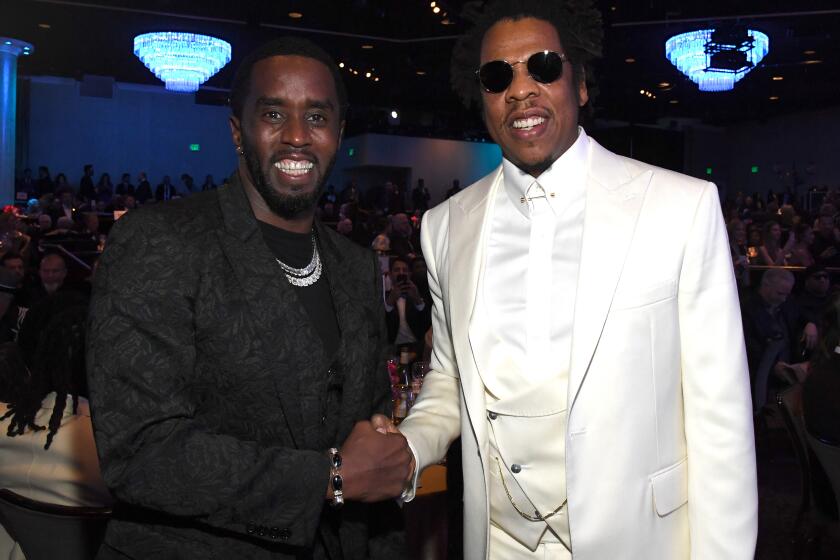More than 90% of recent Grammy nominees are men, USC study finds

A new study looked at the gender breakdown of Grammy Award nominees and proves the old James Brown refrain is still true: It’s a man’s world. (Jan. 25, 2018)
- Share via
A new study on gender and racial figures in pop music proves the old James Brown refrain is still true: It’s a man’s man’s man’s world.
The study, in part, looked at the gender breakdown of Grammy Award nominees, and found a wide imbalance. A total of 90.7% of nominees between 2013 and 2018 were male, meaning just 9.3% were women.
Stacy L. Smith, Marc Choueiti and Kate Pieper, of the USC Annenberg Inclusion Initiative, tracked the gender and racial breakdown of performers, writers and producers across the top echelons of the pop charts and the Grammy Awards.
The full results of the work, titled “Inclusion in the Recording Studio? Gender and Race/Ethnicity of Artists, Songwriters & Producers Across 600 Popular Songs from 2012‐2017,” was released today, a few days before the 60th Grammy Awards.
While one might suspect that an era seemingly dominated by major female stars such as Taylor Swift, Adele and Beyoncé would have a more even split, the workaday figures for representation in pop music today remain startling in their male dominance. And in 2017, the figures seemed to be getting worse.
“That’s a goal, to find out the impediments in the hiring and recruiting process and where there might be bias that excludes women,” Smith said.
Women nominated for Grammy Awards, for instance, were most likely to be recognized for best new artist or song of the year and least likely to be up for producer of the year. In the time period surveyed, not a single woman got a nod in that category.
“One thing that’s important is to not let high-profile women be the sole source of recognition” at the Grammys, Pieper said.
The general figures of the gender breakdown in pop music show similar imbalances. In 2017, 83.2% of artists across the top pop songs were male and just 16.8% were women. That’s a sharp drop-off from 2016, where women were the featured artist on 28.1% of the same charts or even from 2012 with 22.7%.
The numbers get even more skewed when looking specifically at musical groups rather than popular solo acts. For bands, the gender makeup was 91.3% male (70.5% of bands were all men), and for duos, 94.9% of members were male.
“At the top of your mind, you can name prominent female solo artists and think things are good,” Smith said. “This data challenges that, especially with how few women are songwriters and producers.”
One slight upside to the findings: In 2017, slightly more than half of the top acts surveyed were from minority racial or ethnic groups. Specifically, 51.9% of acts surveyed were minorities, a figure 13.5 points higher than five years ago.
In songwriting, the numbers are even more imbalanced. Credited songwriters from 2017 were 87.7% male and 12.3% female, a figure that has barely budged since 2012. Of those female songwriters, 40.2% were from minority groups, including a notable bump in 2017 to 54.4%.
A mere nine male songwriters were responsible for nearly 20% of all songs surveyed in the time period.
Interestingly, the vast majority (nay, all but one) of the top-credited female songwriters were also credited in the survey as artists, while only one male in the same group was a credited artist as well. Female artists were also notably more likely to use female songwriters than their male peers were.
“Those results are encouraging, that female artists are advocating for female peers,” Smith said.
As for production credits, the disparity is so vast as to be almost totally dominated by men. An astonishing 98% of credited producers across the top surveyed songs were men. Only two women of color had production credits among the songs surveyed, and a full 95.7% of songs had no female production credits whatsoever.
“For women of color, that’s an epidemic of invisibility,” Smith said.
In the wake of the #MeToo and #TimesUp movements that have swept through the film and television industries, these figures could be part of a turning point in addressing similar gender disparities in music.
“One thing that’s been interesting to watch in film is the development of a critical mass of people who care about these issues,” Pieper said. “These are all linked issues and they have to be addressed together.”
For breaking music news, follow @augustbrown on Twitter.
ALSO:
More to Read
The biggest entertainment stories
Get our big stories about Hollywood, film, television, music, arts, culture and more right in your inbox as soon as they publish.
You may occasionally receive promotional content from the Los Angeles Times.











